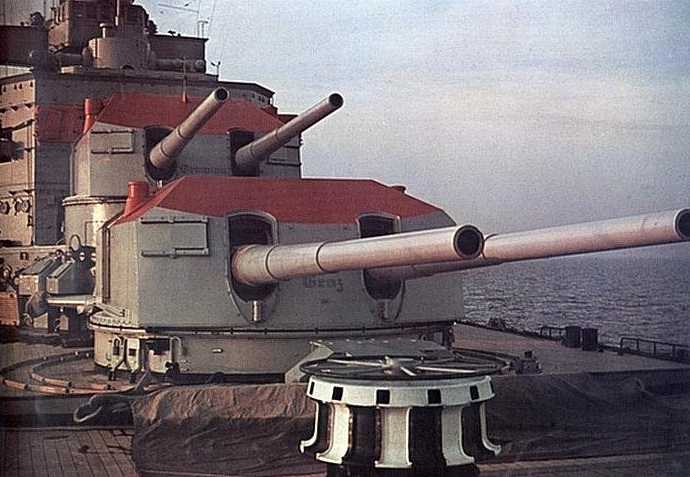This was the only 20.3 cm (8") weapon ever designed by Germany and was quite powerful with a long range. Two of the turrets intended for the uncompleted Seydlitz were mounted as coastal artillery on Ile De Croix. It had been intended to mount the other two at Ile de Ré, but this apparently never took place.
These guns are probably best known for when Prinz Eugen started the Boat Deck fire on HMS Hood shortly before her loss. During the entire Denmark Strait battle, Prinz Eugen fired a total of 183 shells, hitting HMS Hood at least once and HMS Prince of Wales three times.
Four of these guns came into Soviet service when the Germans sold the uncompleted heavy cruiser Lützow to the USSR in 1940. Renamed Petropavlovsk, only two turrets were operational during her early career and she fired 676 rounds in defense of Leningrad. Badly damaged and sunk in shallow water on 17 September 1941, she was later repaired during 1942 with three working 20.3 cm guns. She fired over 1,000 rounds during the Leningrad breakout in January 1944. Renamed Tallin on 1 September 1944. The Soviets were also interested in purchasing the uncompleted heavy cruiser Seydlitz but this was vetoed by Hitler in 1939.
The four turrets intended for the cruiser Seydlitz were instead used as coastal artillery. Two turrets were emplaced at Île de Croix off Lorient and the other two were at Île de Re off La Pailice. Eight further guns were completed as coastal defense guns and then designated as 20,3 cm Kanone (E) L/59. Six of these were captured in France during the Normandy invasion.
At the end of World War II, Prinz Eugen was allocated to the USA. Before being sent to the nuclear tests in the Pacific, her "A" turret guns were removed at the Philadelphia Navy Yard in Pennsylvania and these were then sent to the Naval Weapons Facility at Dahlgren, Virginia, for testing. One gun was scrapped in the 1950s and other remained there on display until sometime in the 1970s when it was also scrapped.
Constructed of loose barrel, an inner and outer jacket, a breech end-piece screwed hot on to the outer jacket and a breech block supporting piece pushed into the breech end-piece and held by a threaded ring. The loose barrel was removable from the rear and would fit any gun. The breech block was a horizontal sliding type and was hydraulically operated.
Actual bore diameter was 20.30 cm (7.992").
| Designation | 20.3 cm/60 (8") SK C/34 |
|---|---|
| Ship Class Used On | Germany: Admiral Hipper and Prinz Eugen Classes
USSR: Petropavlovsk (later Tallin) (ex-German Lützow) |
| Date Of Design | 1934 |
| Date In Service | 1939 |
| Gun Weight | 45,636 lb. (20,700 kg) 1 |
| Gun Length oa | 478.4 in (12.150 m) |
| Bore Length | 453.5 in (11.518 m) |
| Rifling Length | 375.1 in (9.527 m) |
| Grooves | (64) 0.094 in deep x 0.227 in (2.4 mm x 5.76 mm) |
| Lands | 0.165 in (4.2 mm) |
| Twist | Increasing RH 1 in 40 to 1 in 35 |
| Chamber Volume | 4,272 in3 (70.0 dm3) |
| Rate Of Fire | 4 - 5 rounds per minute |
- ^Loose liner weighed 12,300 lbs. (5,580 kg) and the breech mechanism weighed 992 lbs. (450 kg).
| Type | Cartridge - Bag |
|---|---|
| Projectile Types and Weights 1a 2a | APC L/4,4: 269 lbs. (122 kg)
HE L/4,7 base fuse: 269 lbs. (122 kg) HE L/4,7 nose fuse 3a: 269 lbs. (122 kg) HE L/4,7 nose fuse AA 4a: about 265 lbs. (120 kg) Illum L/4,5: 227 lbs. (103 kg) |
| Bursting Charge 5a | APC L/4,4: 5.84 lbs. (2.647 kg) TNT 6a HE L/4,7 base fuze: 11.99 lbs. (5.439 kg) TNT 7a HE L/4,7 nose fuze: 19.59 lbs. (8.884 kg) TNT 8a |
| Projectile Length | APC L/4,4: 35.2 in (89.5 cm)
HE L/4,7 base fuze: 37.6 in (95.6 cm) HE L/4,7 nose fuze: 37.5 in (95.3 cm) Illum L/4,5: 36 in (91.4 cm) |
| Propellant Charge 9a | Fore Charge: 46.5 lbs. (21.1 kg) RP C/38 (835/805 x 11/4.3)
Rear Charge: 65.5 lbs. (29.7 kg) RP C/38 (860 x 11/4.3) |
| Cartridge Case Type, Size and Weight | Brass, 203 x 875 mm, 40.1 lbs. (18.2 kg) 10a |
| Muzzle Velocity | All except illum: 3,035 fps (925 mps)
Illum: 2,297 fps (700 mps) |
| Working Pressure | 20.3 tons/in2 (3,200 kg/cm2) |
| Approximate Barrel Life | 300 rounds (one source says 500 rounds) |
| Ammunition stowage per gun | 120 rounds 11a |
- ^Both the HE L/4,5 Base Fuze and the HE L/4,6 Nose Fuze used a ballistic cap (windshield).
- ^
Actual German designations APC L/4,4 20.3 cm Psgr. L/4,4 (m.Hb) HE L/4,7 base fuze 20.3 cm Spgr. L/4,7 Bdz (m.Hb) HE L/4,7 nose fuze 20.3 cm Spgr. L/4,7 Kz (m.Hb) HE L/4,7 nose fuze AA 20.3 cm Spgr. L/4,7 Kz (m.Hb) – Haube abgeschraubt Illumination L/4,5 20.3 cm Lg. L/4,5 - ^German HE Nose Fuzed projectiles with ballistic caps had a rod between the nose of the shell and the fuze to improve performance when striking obliquely. See details on 12.7 cm SK C/34 datapage.
- ^As of the 1940 publication date of M.Dv. Nr. 170,40, no AA version of the 20.3 cm HE L/4,7 nose fuze was in service for these weapons. However, the post-war USN NAVTECMISEU Technical Report #191-45 "Standard German Projectile Fuzes" lists the time fuze Z.Z. S/60 nA as being used on the 20.3 cm Spgr. L/4,7 Kz (m.Hb) which implicitly means that sometime during the war an AA version of this projectile was issued. These AA shells were reportedly used at least by Prinz Eugen during the Channel Dash (Operation Cerberus) and on 17 May 1942 while transiting from Norway to Germany when she fired AA barrages from "B" and "C" turrets at attacking British torpedo bombers. The AA projectile was the same as the standard HE Nose Fuze projectile, but had a time fuze in place of the instantaneous impact fuze and did not use the ballistic cap (windshield). See Anti-Aircraft Projectiles for a sketch of a similarly modified 15 cm projectile.
- ^Burster weights (reiner Sprengstoff) from M.Dv. Nr. 170,40.
- ^The burster for the APC projectile was made from Fp 15, Fp 5 and Fp 1.
- ^The burster for the HE base fuze projectile was made from Fp 25, Fp 10, Fp 5 and Fp 5.
- ^The burster for the HE nose fuze projectile was made entirely with Fp 1.
- ^These guns, like most large caliber German guns, used a "fore charge" which was propellant in a silk bag, and a "rear charge" which was propellant in a brass case. The brass case helped to seal the breech of the gun.
- ^The cartridge rim diameter was 245 mm.
- ^This is the design figure. "German Warships 1815-1945" says that the actual outfit per gun ranged from 120 to 160 rounds. "German Naval Guns 1939 - 1945" says that in 1940 the total outfit was 320 APC, 320 HE base fuse and 320 HE nose fuze. In addition, "B" and "C" magazines each held 40 starshell. "Warship Pictorial #21" says that in 1944 the total outfit was 1,470 shells of mostly HE plus 40 starshells.
- Bourrelet diameter was 7.976 inches (20.26 cm).
| Elevation | Distance | Striking Velocity | Angle of Fall | Time of Flight |
|---|---|---|---|---|
| 1.9 degrees | 5,470 yards (5,000 m) | 2,441 fps (744 mps) | 2.1 degrees | 6.0 seconds |
| 4.4 degrees | 10,940 yards (10,000 m) | 1,926 fps (587 mps) | 6.1 degrees | 13.6 seconds |
| 8.1 degrees | 16,400 yards (15,000 m) | 1,519 fps (463 mps) | 12.8 degrees | 23.4 seconds |
| 13.3 degrees | 21,870 yards (20,000 m) | 1,253 fps (382 mps) | 23.6 degrees | 35.9 seconds |
| 20.3 degrees | 27,340 yards (25,000 m) | 1,158 fps (353 mps) | 36.8 degrees | 51.1 seconds |
| 29.1 degrees | 32,810 yards (30,000 m) | 1,191 fps (363 mps) | 48.8 degrees | 69.0 seconds |
| 37.0 degrees | 36,636 yards (33,500 m) | --- | --- | --- |
| Distance | Thickness |
|---|---|
| 10,389 yards (9,500 m) | 2.0" (5 cm) of Homogeneous Armor |
| Distance | Thickness |
|---|---|
| 10,400 yards (9,500 m) | 9.4" (24 cm) of Face-hardened Armor |
| 18,300 yards (20,000 m) | 3.9" (10 cm) of Face-hardened Armor |
The above information is from "German Cruisers of World War Two" for a muzzle velocity of 3,035 fps (925 mps) and is based upon German face-hardened (vertical) and homogeneous (deck) armor penetration curves.
| Designation | Two-gun turrets
Admiral Hipper (4) and Prinz Eugen (4): LC/34 |
|---|---|
| Weight 1b | Turrets "A" and "D": 548,951 lbs. (249,000 kg)
Turrets "B" and "C": 577,611 lbs. (262,000 kg) |
| Elevation | Turret "A": -9 / +37 degrees 2b Turrets "B", "C" and "D": -10 / +37 degrees |
| Elevation Rate | 8 degrees per second |
| Train | +145 / -145 degrees |
| Train Rate | 6 - 8 degrees per second |
| Gun recoil | 24.6 in (62.5 cm) |
| Loading Angle | +3 degrees |
- ^Difference in weights was from the thickness of the rear armor and the rangefinders, which were installed only on "B" and "C" turrets.
- ^Negative elevation for "A" turret was limited by the shear of the bow.
- Turrets "A" and "D" each had 72 crewmen. Turrets "B" and "C" each had an additional four men who operated the rangefinders.
- These mountings generally resembled those for the 38 cm SKC/34 guns used on the Bismarck class except that the fore and rear charges were passed by hand to the hoists. Projectiles and the rear charge were rammed hydraulically, but the fore charge was manually loaded. Other differences were "the use of electrically driven Pittler-Thoma hydraulic gear for auxiliary training, the absence of cartridge-ring cars, both rear and fore charges were passed by hand and the presence of two trays in the charge hoist cage with the rear charge above the fore." - "Naval Weapons of World War Two." Auxiliary hoists were similar but electric reserve power for the main loading gear was replaced by hand operation.
- Distance between gun axes was 85.0 in (216 cm).
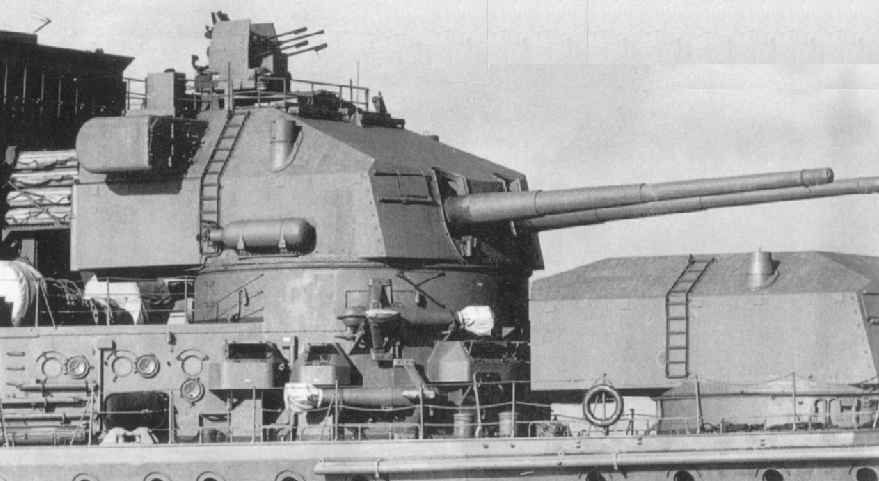
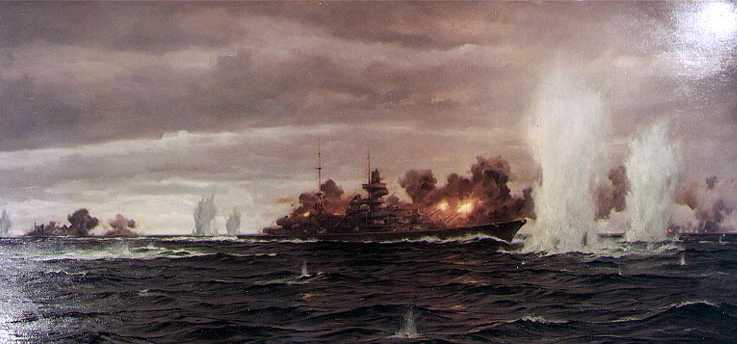
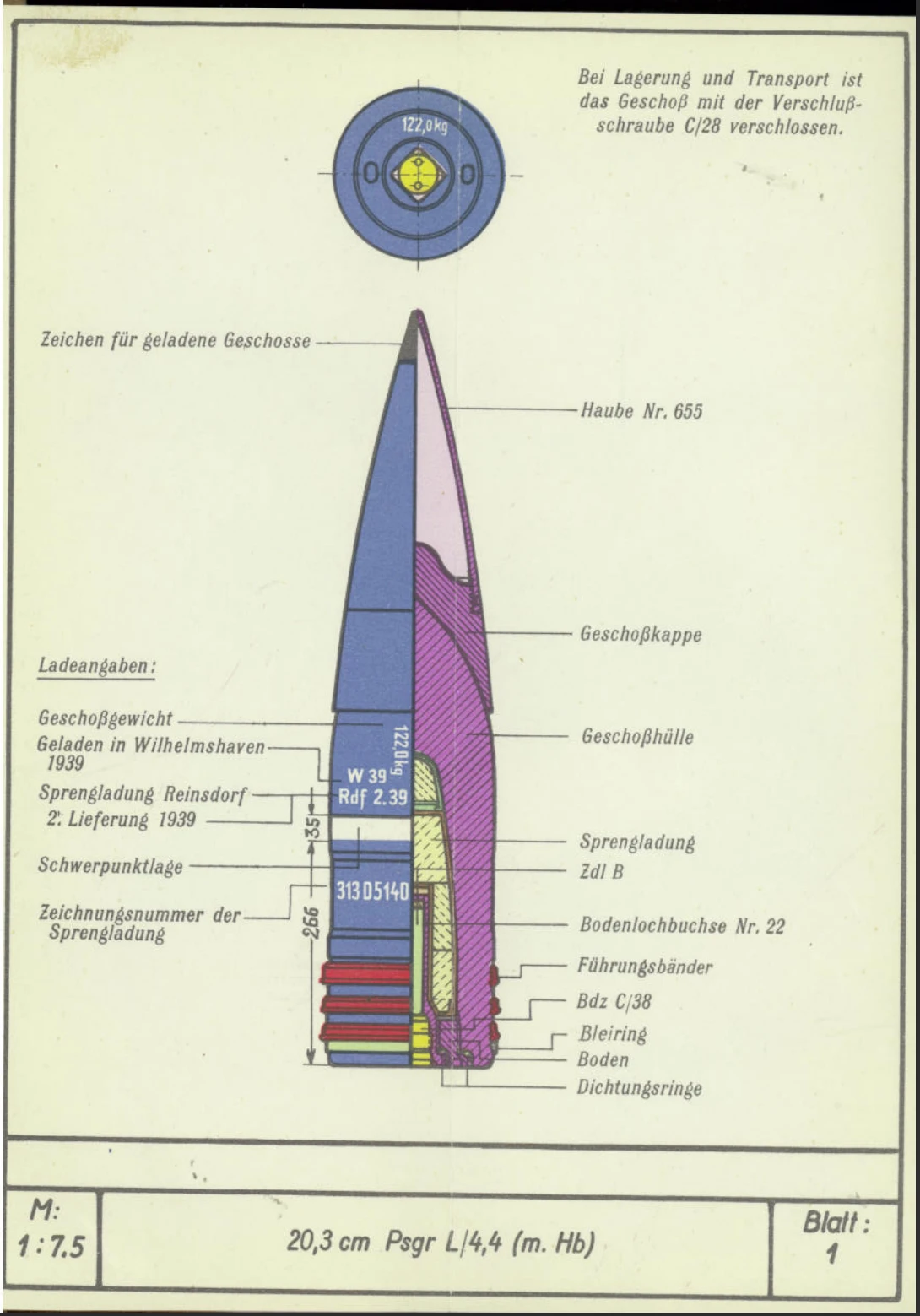
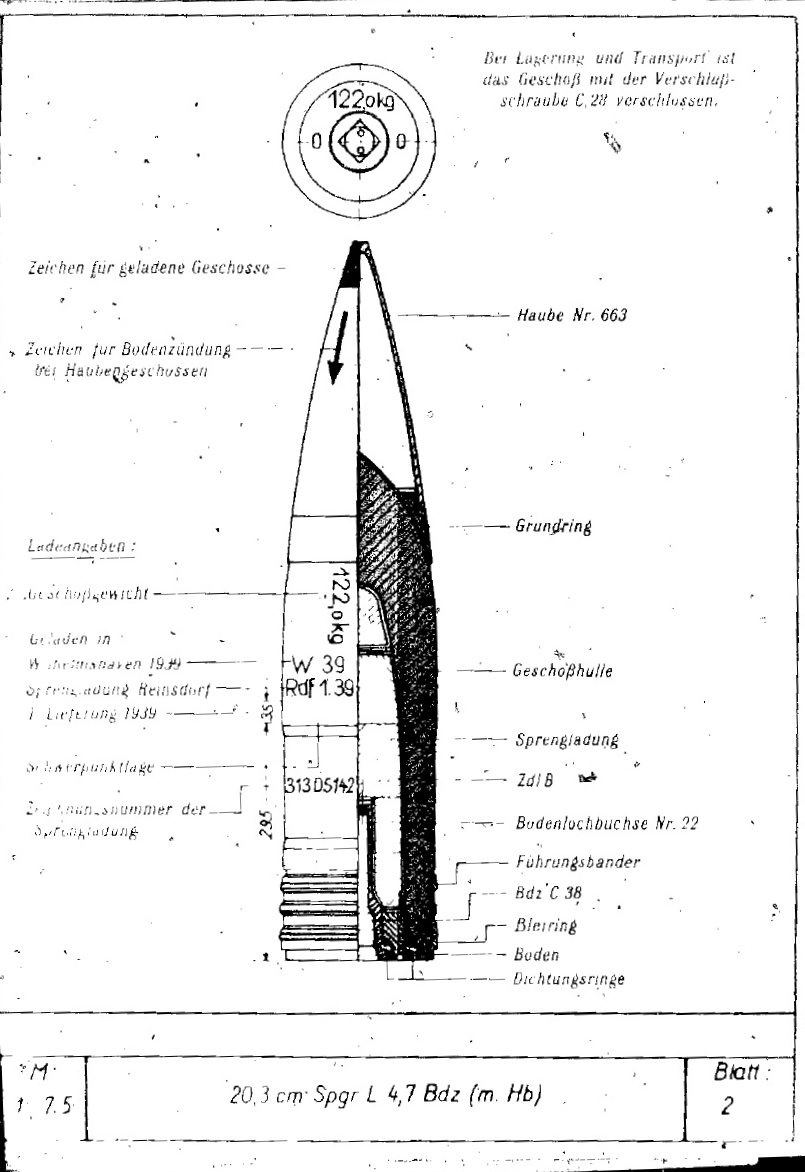
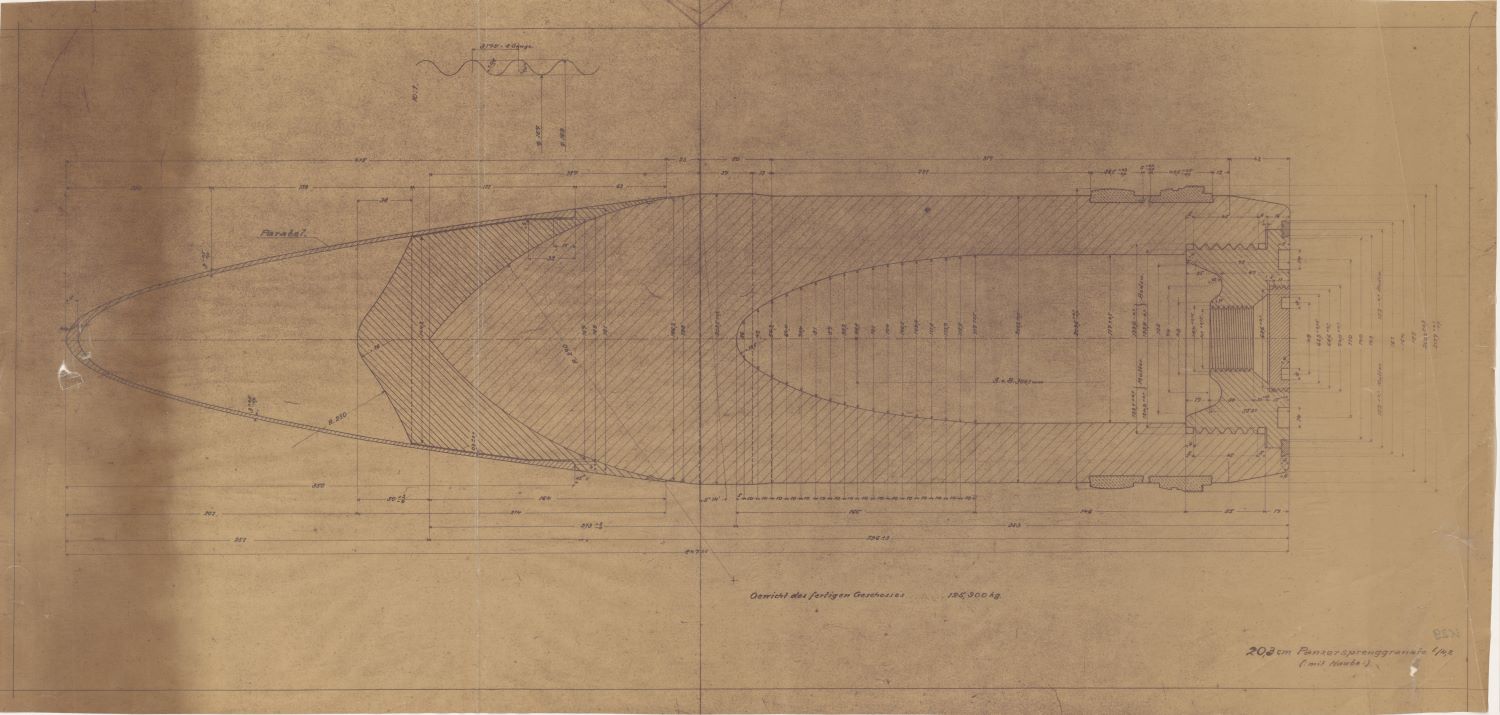
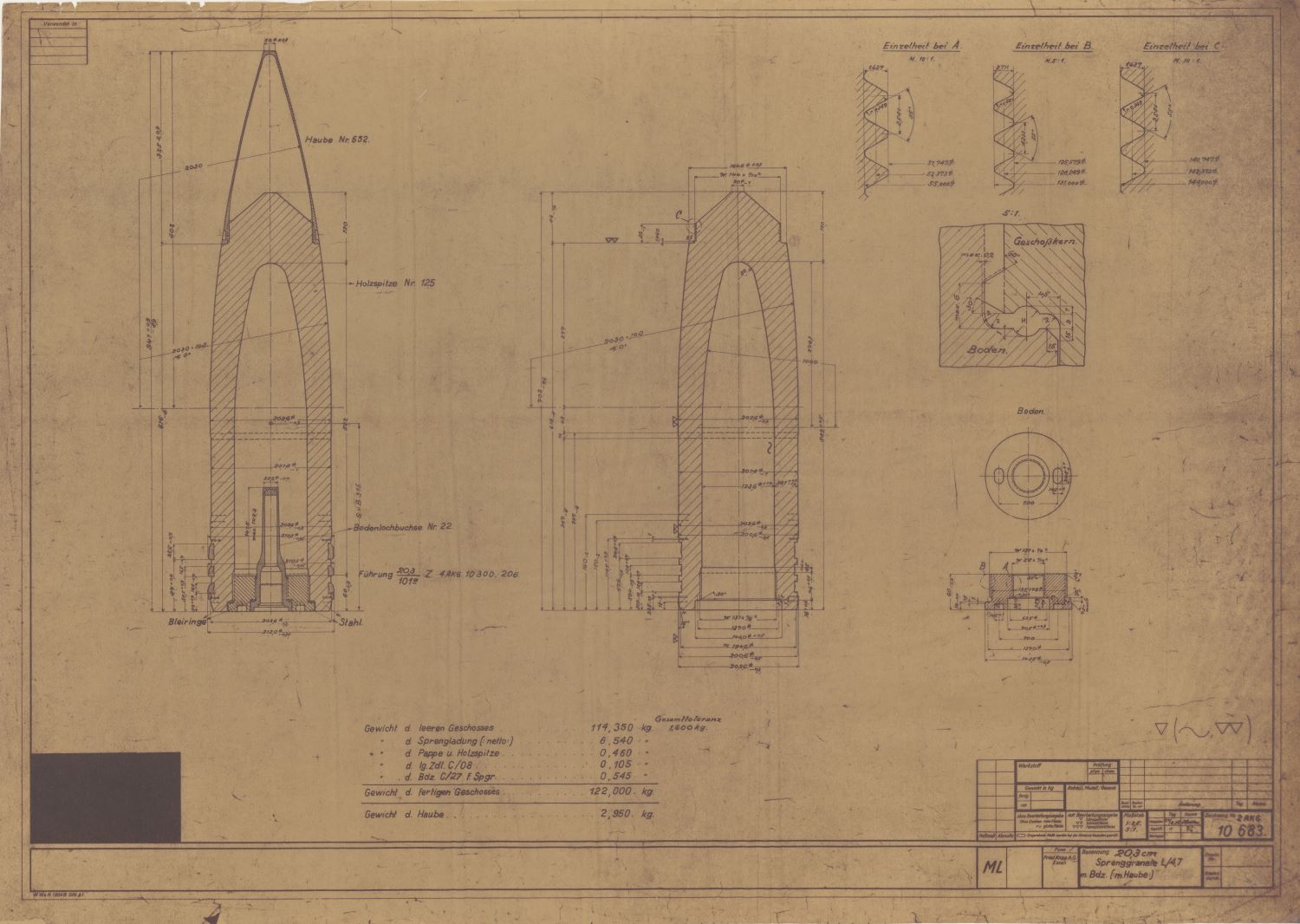
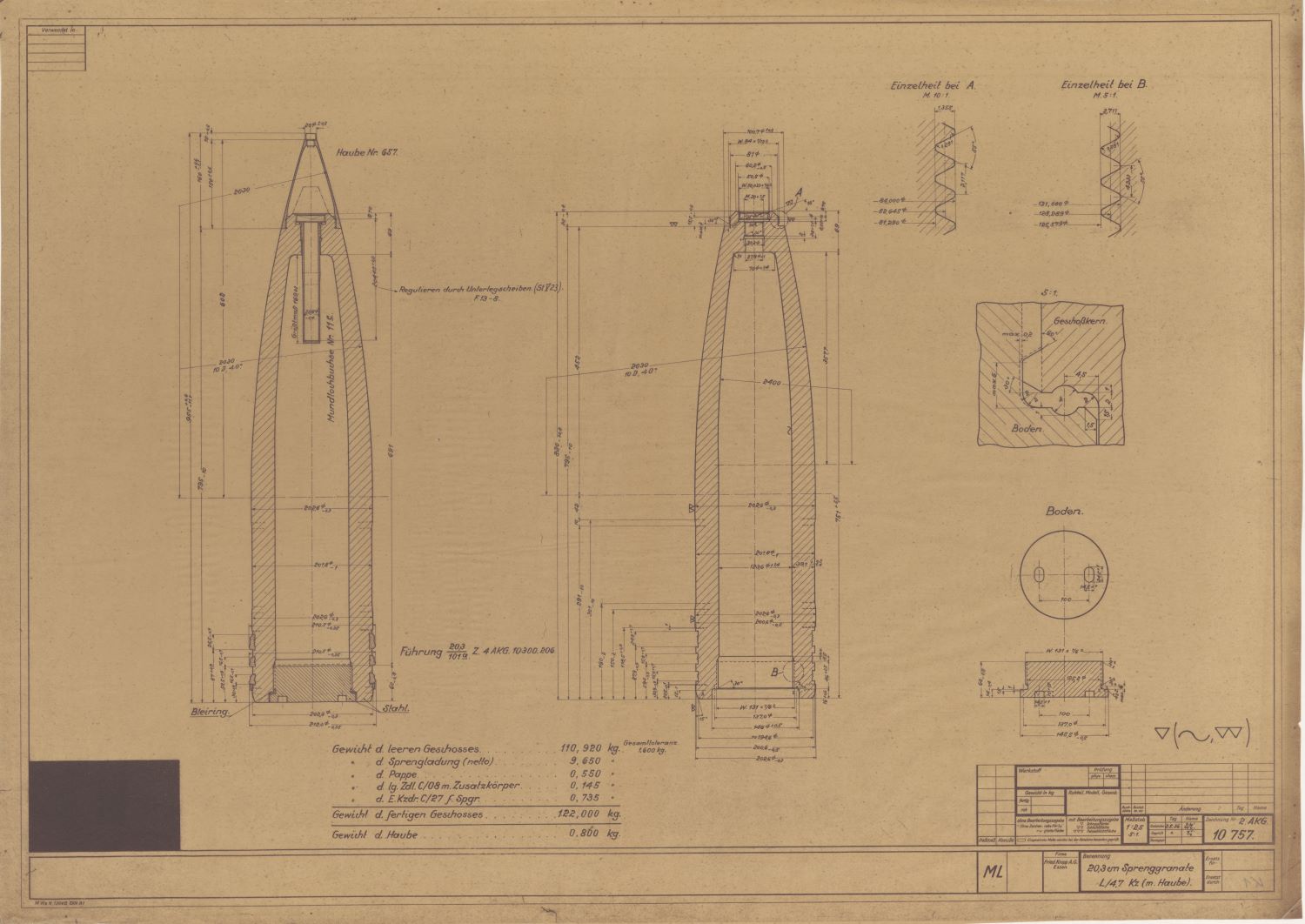
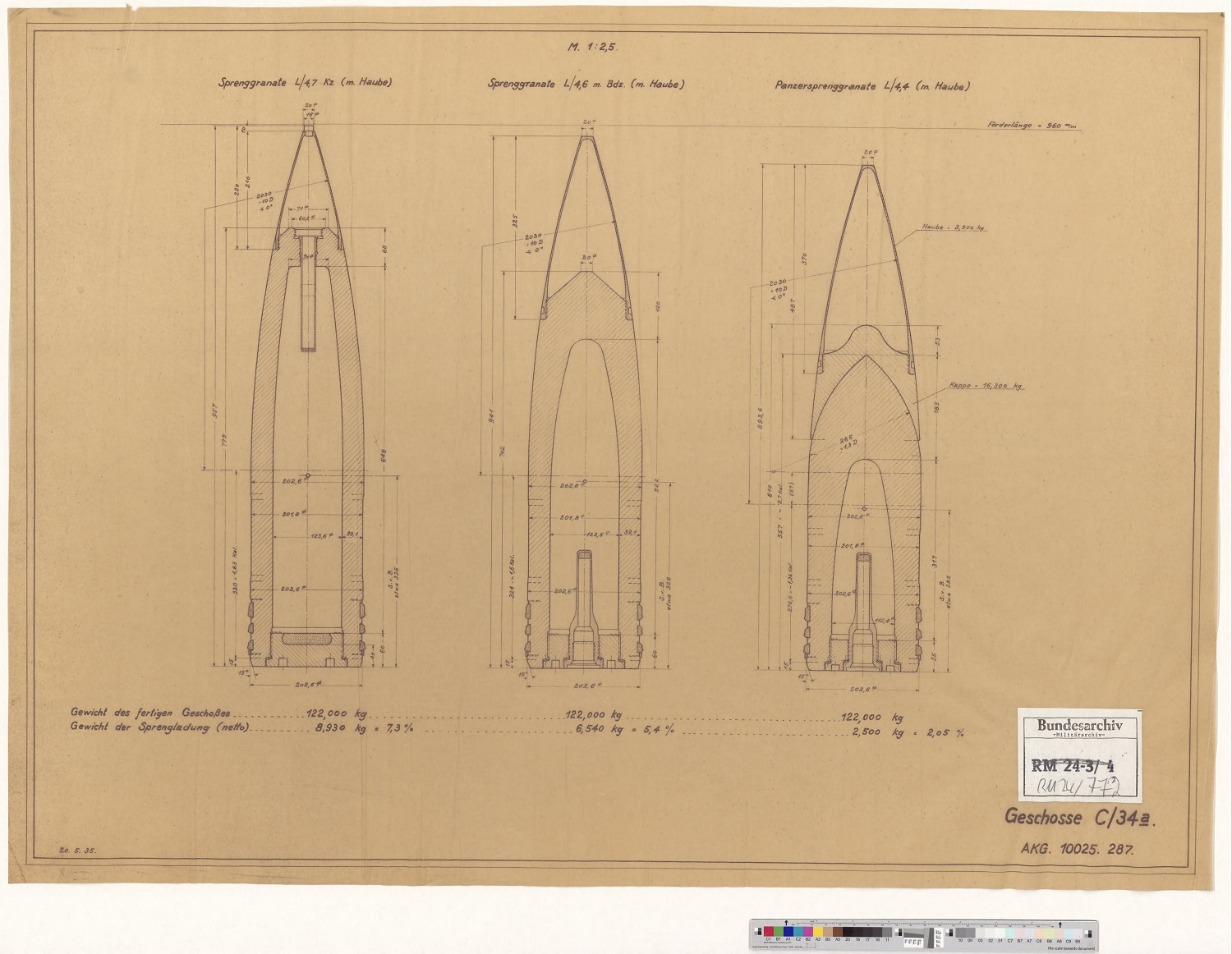
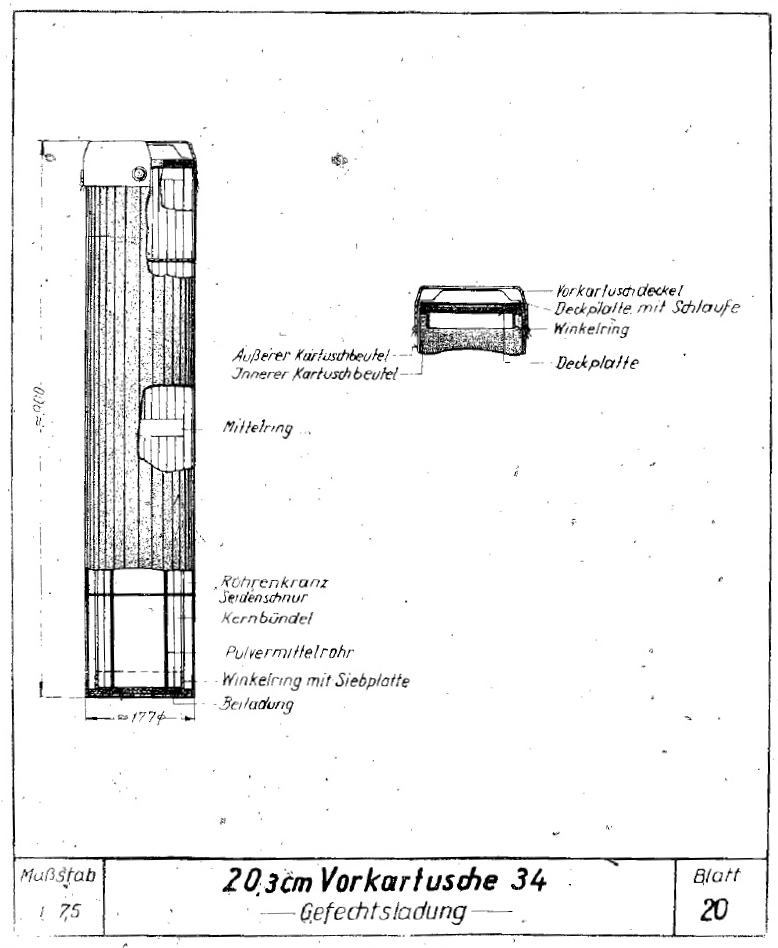
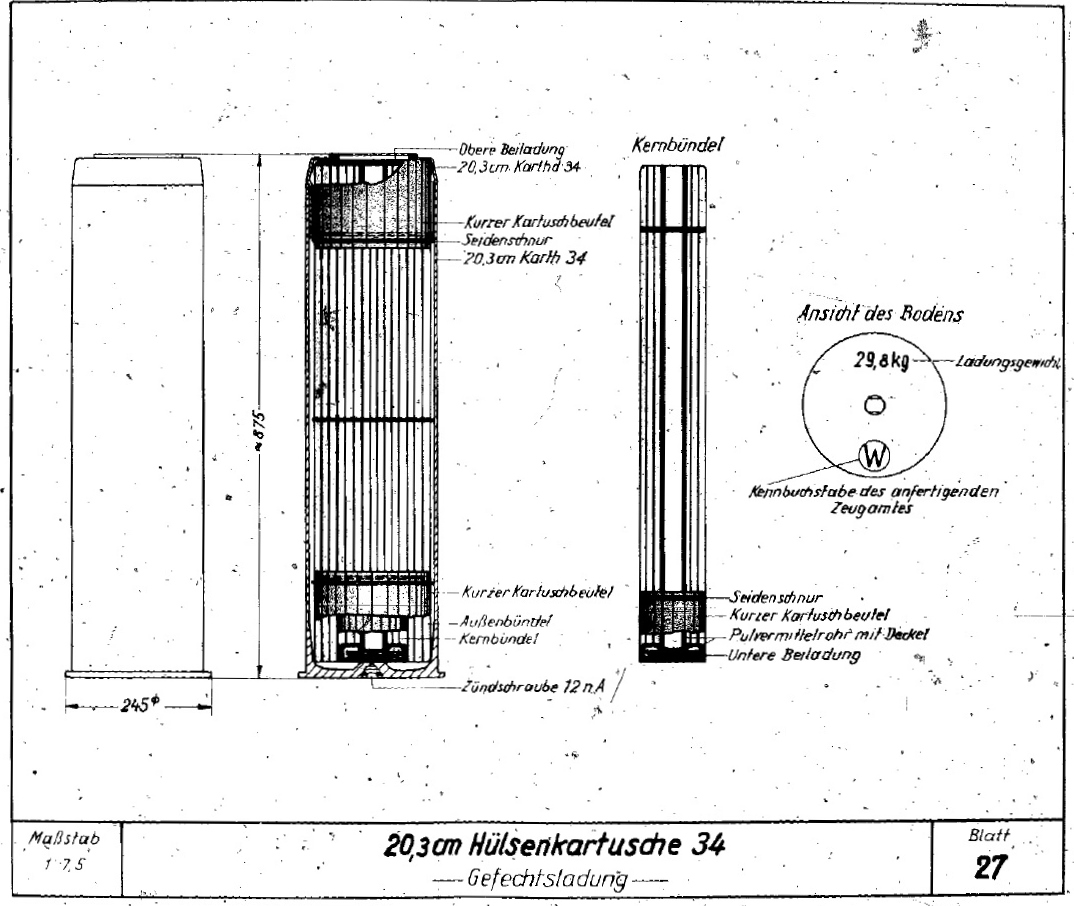
Inside one of Admiral Hipper's Turrets
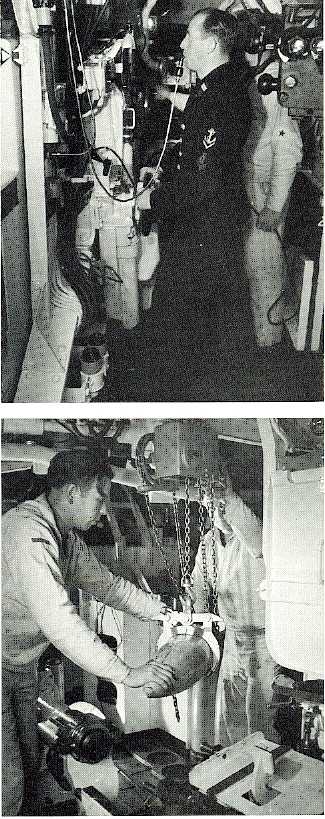
Top: Chief Petty Officer gun captain at quarters firing. The tube in his mouth is the firing mechanism and there is a second trigger on the wheel he is holding.
Bottom: Emergency loading of 20.3 cm (8") shell from ready-use rack. The forward part of the rammer can be seen at lower left.
.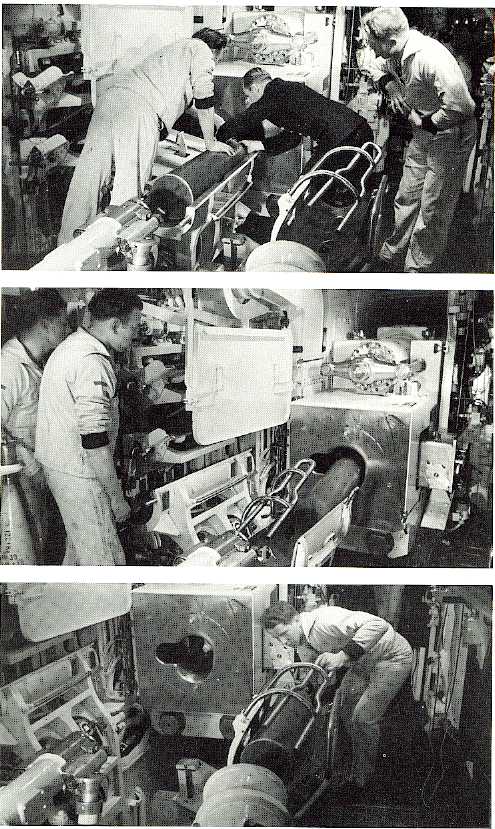
Top: Preparing to ram home the Hülsenkartusche or main charge. The rammer is in the left-hand corner. The framework between the two right-hand crew members is the spent case transfer tray.
Middle: Empty case being ejected from breech onto ejection transfer tray. Note ready-use shells on the left.
Bottom: The breech end of the right-hand gun in one of the turrets. The crewman is ejecting a spent cartridge case down the disposal chute. At the bottom left is the rammer, while above and to the left can be seen the shell loading tray adjacent to the ammunition hoist.

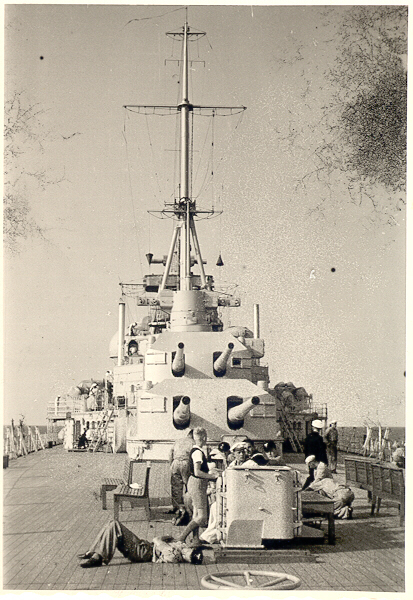
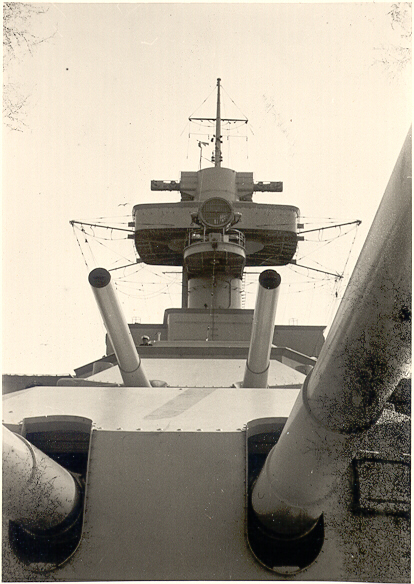
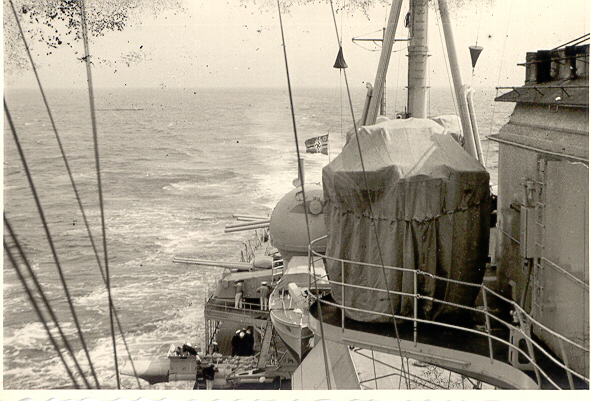
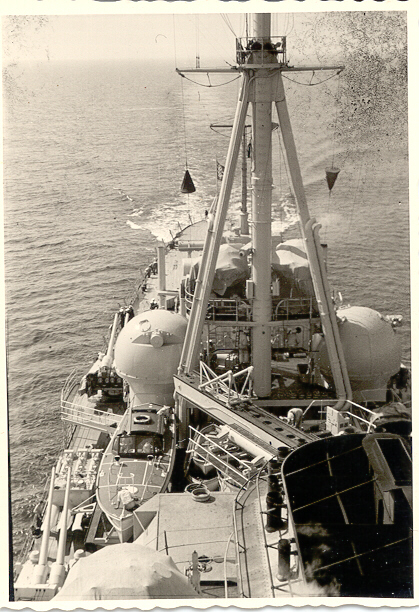

"Anatomy of the Ship: The Battleship Bismarck" by Jack Brower
"Naval Weapons of World War Two" by John Campbell
"German Warships 1815 - 1945" by Erich Gröner
"German Naval Guns 1939 - 1945" by Miroslaw Skwiot
"German Cruisers of World War Two" and "Cruisers of World War Two: An International Encyclopedia" both by M.J. Whitley
"Warship Pictorial #21: Kriegsmarine Prinz Eugen" by Steve Wiper
"Raising the Red Banner: The Pictorial History of Stalin's Fleet 1920-1945" by Vladimir Yakubov and Richard Worth
---
"Merkbuch über die Munition der 20,3 cm SK C/34 der Schiffsartillerie" M.Dv. Nr. 170,40 by Oberkommando der Kriegsmarine
"Munitionsvorschriften für die Kriegsmarine - Hülsenkartusche" M.Dv. Nr. 190,4A1 by Oberkommando der Kriegsmarine
"Munitionsvorschriften für die Kriegsmarine - Vorkartusche" M.Dv. Nr. 190,4A6 by Oberkommando der Kriegsmarine
---
Special help from Peter Lienau, Thorsten Wahl and Zhu Shipeng
Special thanks to Curt Warner, who tracked down the post-war whereabouts of the guns from Prinz Eugen's Turret Anton
Additional Images at Axis History Factbook
Additional information about these weapons may be found in the INRO article, The Loss of HMS Hood
17 January 2007 - Benchmark
19 May 2012 - Updated to latest template
08 December 2014 - Added additional photographs from Peter Lienau
25 May 2015 - Added notes about USSR use and miscellaneous additions
22 February 2018 - Converted to HTML 5 format
27 March 2019 - Added notes to Ammunition section and sketches from M.Dv. Nr. 170,40, M.Dv. Nr. 190,4A1 and
M.Dv. Nr. 190,4A6
03 September 2019 - Added link to AA Projectile section and comment about AA fire on 17 May 1942
03 June 2021 - Corrected typographical error
21 March 2023 - Added shell expenditure and number of hits for Denmark Strait battle
14 October 2023 - Added comments about USSR Petropavlovsk / Tallin
24 November 2023 - Changed description
08 January 2024 - Added projectile comparison sketch and the fate of the two guns at Dahlgren
07 June 2024 - Added bourrelet diameter
29 August 2024 - Added burster notes and propellant information
30 December 2024 - Added comments on guns used in coastal batteries, ammunition outfits and projectile dimensional drawings
01 March 2025 - Minor changes

